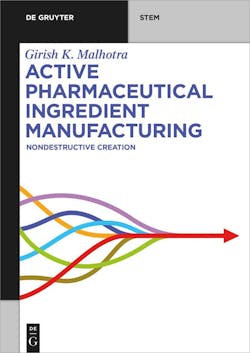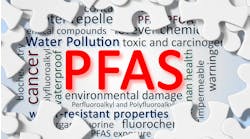Chemical Processing Book Club: Transforming Pharmaceutical Manufacturing
With an aim to address the need for simplification and environmental improvement in pharmaceutical manufacturing processes, Girish K. Malhotra's book "Active Pharmaceutical Ingredient Manufacturing: Nondestructive Creation" explores the historical evolution of the pharmaceutical industry, emphasizing the necessity of environmentally friendly approaches and social and chemical behavior exploitation. Malhotra, president of EPCOT International, taps his 50+ years of experience in manufacturing, R&D, process and technology to help reduce environmental impact, enhance profitability and create a positive legacy for future generations.
Chemical Processing recently discussed his motivation for writing the book.
What motivated you to write this book?
De Gruyter contacted me to write a book about manufacturing practices used to produce Active Pharmaceutical Ingredients. These ingredients are fine/specialty chemicals that have disease-curing value. Since the available books do not describe the chemical processes used and how to simplify them, there has been a need. In the chemical industry, generally, simplification happens after the product is commercial. However, due to high profits, speed to market and requirement for potential regulatory re-approval of the drug, process simplification after commercialization does not happen at all in the pharmaceutical industry. The environmental impact is very high.
Process simplification has to start at the inception of the product and is not discussed. This became an opportunity for me to share my experience and knowledge. Concepts outlined and reviewed are applicable to fine/specialty chemicals, additives, coatings, polymers etc., and all across the chemical industry.
What are some of the fundamental concepts readers can expect to learn from this book?
Looking over the history of the pharmaceutical industry, I had not seen anything documented about “how the pharmaceutical industry evolved.” Chapter 1 describes how the chemical companies discovered disease curing value of chemicals and how their manufacture could be fitted into their existing equipment. Many became today’s pharmaceutical companies. Due to profitability and speed to market, there has been no or very little process methodologies innovation. Regulators also have been an obstacle to innovation. Current practices have huge environmental impacts and need to be understood. We need to minimize environmental impact.
Fundamentals and concepts taught in chemical engineering and chemistry applied differently can remedy the current situation. They are reviewed and discussed through illustrations.
Chemical and physical properties of the raw materials, solvents and intermediates can be extensively exploited to develop and commercialize an excellent process. We are taught about their chemical behavior. Each chemical also has a mutual social behavior. We are generally not taught how to capitalize on their social and chemical behavior “sociochemicology” to create excellent processes. Through examples, possibilities are discussed.
We as chemical engineers are taught how to use equipment discussed in chemical engineering books. Other industries use equipment specific to their needs. It is possible to cross-fertilize their use to simplify chemical manufacturing processes.
Costing and methods of various synthesis routes are reviewed. Such exercises simplify process selection and routes. Ongoing cost analysis assists process selection and profitability when commercial.
We all know that no task is complete without paperwork. Engineers and scientists have a lethargy for paperwork. The book emphasizes the need for process design and an operating manual. They are of extreme value as the designer’s rationale is documented. They can be used for any needed troubleshooting, expansion, personnel training and compliance with regulatory issues.
Can you highlight any challenging topics that your book addresses?
Since the inception of the pharmaceutical industry, processes are fitted in the available existing equipment. Their environmental impact is huge. Processes require a re-look. Simplification and creation of environmentally friendly processes are a challenge that comes with experience. One has to look at each process as if the developer and designer is the process operator. This challenge leads us to create simple and efficient processes. Routes and methods discussed through examples show possibilities.
Were there any specific gaps in existing resources that you aimed to fill with your book?
Our chemical engineering curriculum teaches us the fundamentals of chemical engineering. However, we are not taught how to simplify or troubleshoot processes. This book, through examples, illustrates many of the possibilities.
Please share any practical examples or case studies that readers might find valuable.
A significant number of examples are included in the book. There are many proprietary cases. Chemistry synthesis process patents are an excellent source about how to create and simplify manufacturing processes. They can be used and cross-referenced to create simpler processes.
Apart from your book, what other resources or references do you recommend to readers who want to continue learning about this topic?
I have not come across many references that discuss similar methods.
Have you received any feedback from readers or professionals in the field about how your book has helped them?
There has been a positive response to my book on Amazon. Here are few excerpts from those reviews:
“By coining the term “socio-chemicology,” Malhotra addresses how the mutual behavior of chemicals can be used to reduce the carbon footprint or E-factor while producing APIs. The author opines that pharma has the worst E-factor record of all chemical-producing industries.
The author’s critique of API manufacturing equipment is that many currently used tools are not designed for optimized production. For example, some of the manufacturing equipment the author has proposed, like the plate and frame heat exchangers as reactors, could be considered by an industry that still uses huge reactor vessels to do its reactions. A careful marriage of process and equipment could eliminate the current use of huge quantities of solvents, thus making these manufacturing processes more sustainable. Taking a hands-on approach to addressing the manufacturing of APIs, the author breaks down the steps to designing and con-trolling an effective manufacturing process into a 14-step process that any novice can follow and can be used for training and trouble shooting.”
— Albinus D’Sa (Former US FDA reviewer, compliance officer, and Deputy Country Director of US FDA India Office)
“A not-to-miss part of the book is the roadmap outlined in the final chapter where the author makes a compelling case for the new mindset required and for the systematic adoption of the “nondestructive creation” methodology first conceived and developed by Edmund Phelps, the 2006 Nobel Memorial laureate in economic sciences. The point is that all the basic conceptual tools and mathematical modeling techniques for scaling up processes from the lab to world-class production plant scale already exist. Hence there’s little or no risk of the kind often associated with “creative destruction” resulting from first-of-its-kind or new-to-the-world manufacturing practices or technologies. What’s needed most, however, is the spirit of collaboration across organizational silos, such as procurement, research & development, and sales & marketing. Easier said than done, of course, but the size and scope of the ultimate prize is such that it’s worth all the effort.”
— Digital polymath
What impact do you hope your book will have on readers?
If we create and simplify chemical manufacturing processes from inception, we can and will significantly lower the environmental impact of these manufacturing processes (fine/specialty, active ingredients and their formulations, additives, flavors and fragrances). That will be our gift to the coming generations. Done from the onset, companies will have higher profits and significantly lower environmental impact.




